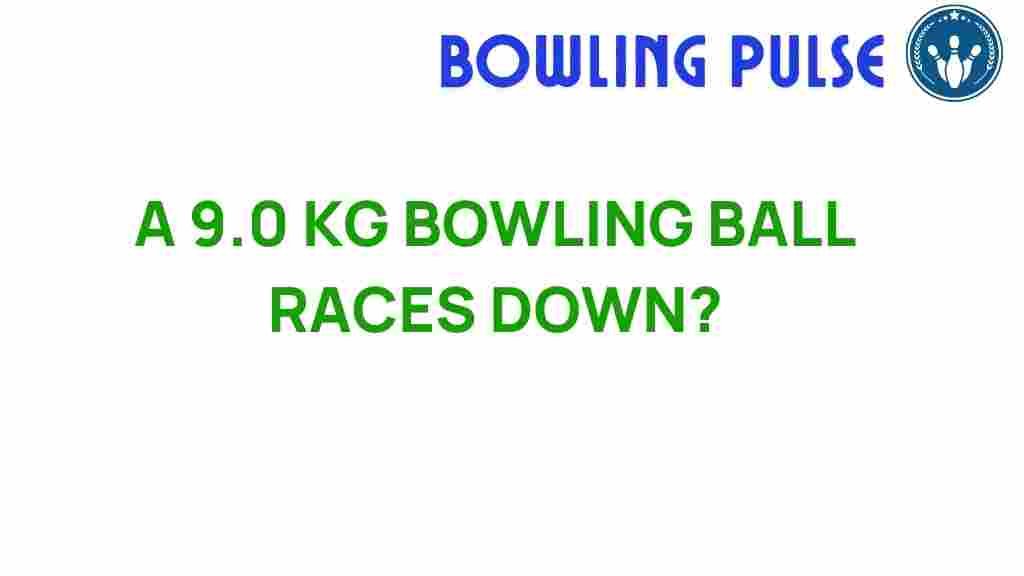Bowling Ball Physics: What Happens When a 9.0 KG Bowling Ball Hits the Lane?
Bowling is more than just a recreational activity; it’s an intricate blend of art and science. Understanding the physics behind a 9.0 KG bowling ball hitting the lane can significantly enhance your bowling performance. In this article, we will delve into the fascinating world of bowling ball physics, explore lane dynamics, and analyze the impact of a bowling ball as it strikes the wooden or synthetic surface of the lane. Whether you’re a beginner or an experienced bowler, having knowledge of these concepts can improve your technique and overall game.
The Basics of Bowling Ball Physics
Bowling ball physics encompasses various principles of sports science that dictate how a bowling ball behaves when it’s rolled down the lane. Key factors include:
- Mass and Weight: A standard bowling ball weighs 9.0 KG (approximately 20 pounds), which significantly influences its momentum and impact on the lane.
- Friction: The interaction between the ball and the lane surface affects the ball’s spin and trajectory.
- Gravity: This force plays a crucial role in how the ball travels down the lane and how it interacts with the pins.
- Velocity: The speed at which the ball is rolled determines its kinetic energy upon impact.
Step-by-Step Analysis of Impact
When a 9.0 KG bowling ball hits the lane, several physical phenomena occur. Let’s break down the process:
1. The Release
The bowler initiates the shot by releasing the ball. The initial velocity is crucial as it determines how quickly the ball will reach the pins. A faster release typically leads to a higher impact force.
2. The Roll
Once the ball leaves the bowler’s hand, it begins to roll. The interaction between the ball and the lane creates kinetic friction, which affects the ball’s spin and direction. The type of surface (wood vs. synthetic) can alter this interaction significantly.
3. The Impact with the Lane
As the bowling ball hits the lane, it compresses slightly upon contact. This compression is a crucial factor in impact analysis since it absorbs some energy, affecting how much energy is transferred to the pins.
4. The Reaction
After the impact, the ball continues to roll, and its direction may shift based on the angle of impact and the frictional forces at play. This phase is vital for lane dynamics, as it influences where the ball will head towards the pins.
Understanding Lane Dynamics
Lane dynamics refer to how various factors influence the ball’s path and behavior on the lane. Key elements include:
- Surface Material: The frictional properties of wood and synthetic lanes can vary, affecting how the ball rolls and hooks.
- Oil Patterns: The application of oil on the lane significantly alters how the ball behaves. Different oil patterns can either assist or hinder a bowler’s performance.
- Bowling Techniques: The way a bowler delivers the ball affects its trajectory and spin, which in turn influences how the ball interacts with the lane and the pins.
Impact Analysis: Energy Transfer
When the bowling ball strikes the lane, several energy transfer processes occur:
- Kinetic Energy</: This is the energy of motion. The faster the ball is rolled, the more kinetic energy it has.
- Elastic Potential Energy: Upon impact, the ball compresses, storing some energy temporarily. This energy is then released as the ball rebounds, affecting its subsequent motion.
- Sound Energy: The impact generates sound, which is not just a byproduct but an indicator of the force of impact.
Bowling Performance: Improving Your Game
Understanding bowling ball physics can directly enhance your bowling performance. Here are some techniques and tips:
- Choose the Right Ball: Ensure your bowling ball is the appropriate weight and fit for your hand. A 9.0 KG ball may be too heavy for some, affecting their release and control.
- Perfect Your Release: Practice your release technique to achieve a consistent velocity and spin. This is crucial for maximizing energy transfer and hitting the pins effectively.
- Study Lane Conditions: Pay attention to how the oil pattern affects your shot. Adjust your approach and ball choice based on lane dynamics.
- Experiment with Spin: Varying the amount of spin can alter the ball’s trajectory and impact the pins differently.
Equipment Testing
When considering bowling sports, equipment testing is essential. Here’s how to effectively evaluate your bowling setup:
- Ball Performance: Test different bowling balls to see how they react on various lane conditions. This can help you find the ideal ball for your style.
- Shoe Selection: The right bowling shoes can improve your slide and stability, enhancing your overall performance.
- Grip and Release Aids: Experiment with different grips and release aids. They can help improve your technique and consistency.
Troubleshooting Common Issues
Even with the best techniques and equipment, bowlers may face challenges. Here are some common issues and troubleshooting tips:
- Ball Hooking Too Much: If your ball hooks excessively, consider adjusting your release angle or the amount of spin you apply.
- Ball Not Hooking Enough: A lack of hook might be due to insufficient speed or a poorly matched ball to lane conditions.
- Inconsistent Release: Ensure you are maintaining a relaxed grip and steady arm motion throughout your delivery.
Conclusion
Understanding what happens when a 9.0 KG bowling ball hits the lane involves a blend of physics, technique, and equipment knowledge. By applying principles of bowling ball physics and lane dynamics, bowlers can enhance their performance and enjoyment of the sport. Whether you are honing your skills or just starting, remember that every roll is an opportunity to learn and improve.
For more information on bowling techniques and sports science, you can explore resources like Bowling Science or read more about the technical aspects of the game in articles available on Bowling.com.
This article is in the category Techniques and created by BowlingPulse Team
